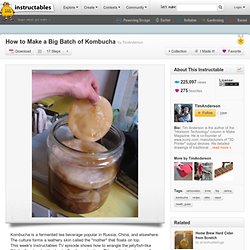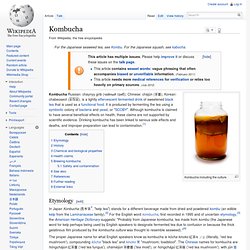

Kombucha Remix. New methods of brewing, mixing, and imbibing put the fun back into this fermented favorite. Tart and effervescent, polarizing and mystical, kombucha has taken the fermented beverage market by storm with its uniquely vinegary flavor and alleged ability to treat everything from arthritis to dull hair to liver disease. Whether concocted in your kitchen, sipped in a cool cocktail, or slipped into a culinary creation, this versatile elixir made from tea goes way above and beyond natural-foods market shelves. Here are a few new ways to enliven your obsession with this quirky quencher. Brew Your Own BatchMany find this fizzy drink’s invigorating qualities near addictive, but at $3 to $4 (or more) per bottle, it can be an expensive habit. Fortunately, DIY methods are simple and cost-efficient, requiring only a few ingredients and a kombucha mother or “SCOBY”—Symbiotic Culture Of Bacteria and Yeast, that is.
How to Make a Big Batch of Kombucha. Kombucha is a fermented tea beverage popular in Russia, China, and elsewhere.

The culture forms a leathery skin called the "mother" that floats on top.This week's Instructables TV episode shows how to wrangle the jellyfish-like "Mother" and make Kombucha 5 gallons at a time. This method produces a fizzy carbonated kombucha that tastes very much like hard apple cider. For background on this bizarre beverage, read Arwen's Making Kombucha Instructable and the Wikipedia Kombucha article. Some confusion arises from the existence of a Japanese kelp tea also called "kombucha". Back to the blob:For me it all started when my friend Anne Harley went to Russia, made herself fluent in the language, joined a band of gypsy musicians, and went on tour with them.Did you know Russian Gypsies have a caste system that dates back to their origins in India?
Since then I've made hundreds of gallons of Kombucha for my friends and myself. Anne's Recipe:6 tsp tea6 cups h2o = 1.5 quarts1 cup sugar. Kombucha. Kombucha including the culture Etymology[edit] In Japan Konbucha (昆布茶?

, "kelp tea") stands for a different beverage made from dried and powdered kombu (an edible kelp from the Laminariaceae family).[2] For the English word kombucha, first recorded in 1995 and of uncertain etymology,[3] the American Heritage Dictionary suggests: "Probably from Japanese kombucha, tea made from kombu (the Japanese word for kelp perhaps being used by English speakers to designate fermented tea due to confusion or because the thick gelatinous film produced by the kombucha culture was thought to resemble seaweed). "[4] The proper Japanese name for what English speakers know as kombucha is kōcha kinoko 紅茶キノコ (literally, 'red tea mushroom'), compounding kōcha "black tea" and kinoko 茸 "mushroom; toadstool".
A 1965 mycological study called kombucha "tea fungus" and listed other names: "teeschwamm, Japanese or Indonesian tea fungus, kombucha, wunderpilz, hongo, cajnij, fungus japonicus, and teekwass History[edit] F.A.Q. - Kombucha America - Frequently Asked Questions Page. What is a Kombucha Mushroom?

The Kombucha Mushroom is not a true mushroom but pseudo lichen. It is a fibrous cellulose spongy membrane that is formed by the various Kombucha bacteria and yeast cells that live in the liquid sugary tea. It is primarily grown to act as an evaporation cap to keep the tea from evaporating and also to prevent other microorganisms from getting to the sugary tea.
It has no sex, and produces no seeds or spores for the purpose of reproduction but within the cells of the membrane are contained the same bacteria and yeasts cells that exist within the tea. When your transfer a newly formed mushroom to a new batch of tea you introduce these bacteria and yeasts to the new tea which quickly colonize it, cause the tea to ferment, and grow a new membrane on the surface.